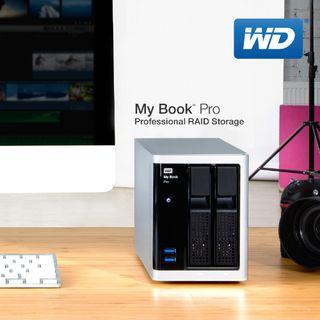WD My Book Pro Thunderbolt 2-Bay Boasts 435 MB/s Speed
Western Digital entered the Thunderbolt storage market and had success in a niche dominated by professionals. A/V, photography, and other multimedia users rely on external storage that is both large-capacity and fast for production work. To keep pace with new trends and user demand, WD releases a few Thunderbolt products each year that one-up the previous models.

The WD My Book Pro released today scales to 12 TB of raw capacity and features two Thunderbolt 2 connectors for high speed data transfers. To get the density and performance required for industry professionals, WD utilized the latest 7,200 RPM hard disk drives and combined them in RAID 0. Users have the option to reconfigure the array to RAID 1 for redundant storage that mirrors the data across the two drives. This decreases the likelihood for data loss.
"The My Book Pro device has been designed from the ground up for the creative professional workflow. We've been able to take the newest, highest capacity 6 TB 7200 RPM drives on the market and marry them with leading technologies to deliver a product you can leverage from the moment you connect it," said Sven Rathjen, vice president of marketing for WD's Content Solutions business. "It really is designed to perform under the most demanding environments."
Thunderbolt 2 delivers up to 20 Gb/s of bandwidth that can be spread to multiple devices by daisy-chaining components. The My Book Pro incorporates two USB 3.0 ports to make better use of the high-speed bandwidth available. Transfer performance is said to be 435 MB/s, more than enough to edit 4K video in real time.
It looks like Western Digital is taking full advantage of the new 3.5" Black Edition desktop drive that it launched just a few days ago. We look forward to seeing what it and the latest Red Pro 6 TB 7,200 RPM drives can offer in terms of performance.
The new My Book Pro is available from the WD Store starting today. Pricing comes to $999.00 (12 TB), $899.00 (10 TB), $749.00 (8 TB) and $599.00 (6TB). The wide selection of capacity sizes gives users a nice range of price points while shopping for a high-performance direct-attached storage (DAS) solution.
Stay on the Cutting Edge
Join the experts who read Tom's Hardware for the inside track on enthusiast PC tech news — and have for over 25 years. We'll send breaking news and in-depth reviews of CPUs, GPUs, AI, maker hardware and more straight to your inbox.
-
f-14 it's a gimmick that takes advantage of the cache of the hard disks being increased to 128MB per disk and is not sustainable beyond the drive cache being filled when stripped in 128MB chunks by each driveReply
435/128=3.3 roughly so 4 drives could eat 435MB in a second.
i would like to see the test chart showing the sustained speed which is probably only for 1.3 seconds that this can be accomplished. being impressed would require 6-60 minutes at this speed which no hard disk drive heads could sustain until 10 years from now at the soonest, but i would bank more upon 25 years.
RAID 0 (also known as a stripe set or striped volume) splits ("stripes") data evenly across two or more disks, without parity information, redundancy, or fault tolerance. Since RAID 0 provides no fault tolerance or redundancy, the failure of one drive will cause the entire array to fail; as a result of having data striped across all disks, the failure will result in total data loss. This configuration is typically implemented having speed as the intended goal. RAID 0 is normally used to increase performance, although it can also be used as a way to create a large logical volume out of two or more physical disks. -
BorgOvermind 435 MB/s would imply a RAID 0 of 3 drives.Reply
I get about same speed from my old 2TB black drives, also 3 in RAID 0.
As a note, drives finally exceeded 150MB/s - that's SATA 1 speed.
Most Popular


